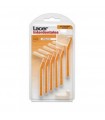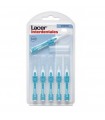Description
Brush type: interdental
Head shape:
- straight (CN 163243.2, 150530.9)
- fine straight (CN 150528.6)
- conical rectum (CN 150529.3)
- extra-large rectum (CN 163239.5, 163240.1, 150527.9)
- ultra-thin rectum (CN 159268.2, 171675.0)
- angular (CN 163244.9)
- soft angle (CN 150526.2)
- thin angle (CN 150523.1)
- ultra-thin angle (CN 159270.5, 171676.7)
- conical angle (CN 150525.5)
- extra-large angle (CN 163241.8, 163242.5, 150522.4)
Fiber material: tynex
Number of rows:
- 2 (CN 150526.2, 150530.9)
- 3 (CN 163239.5, 163241.8, 150522.4, 159268.2, 159270.5, 171675.0, 171676.7)
- 4 (CN 163240.1, 163242.5, 163243.2, 163244.9, 150523.1, 150528.6)
- 5 (CN 150525.5, 150529.3)
Number of plumes per row: 100
Hardness:
- soft (CN 163239.5, 163241.8, 150522.4, 159268.2, 159270.5, 150523.1, 150525.5, 150526.2, 150527.9, 150528.6, 150529.3, 150530.9, 171675.0, 171676.7)
- medium (CN 163240.1, 163242.5, 163243.2)
- hard (CN 63244.9)
Particular features:
- mild extrafine (CN 163239.5, 163241.8): for the hygiene of narrow and very sensitive interdental spaces. Also indicated in case of gingival sensitivity, gums prone to bleeding, surgically intervened areas, furcal areas, recent implants and in new orthodontic carriers.
- extra-large (CN 163240.1, 163242.5, 150522.4, 150527.9): for the hygiene of very narrow interdental spaces.
- ultra-thin (CN 159268.2, 159270.5, 171675.0, 171676.7): for the hygiene of extremely narrow interdental spaces
- fine (CN 150523.1, 150528.6): for the hygiene of narrow interdental spaces
- conical (CN 150525.5, 150529.3): for the hygiene of medium and large interdental spaces. Suitable for fixed prostheses, implants and orthodontic carriers
- soft (CN 150526.2, 150530.9): for the hygiene of narrow and very sensitive interdental spaces. Also indicated in cases of gingival sensitivity, gums prone to bleeding, surgically intervened areas, furcal areas, recent implants and in new orthodontic carriers.
They incorporate textured Tynex filaments that allow the removal of bacterial plaque in interdental spaces and in hard-to-reach areas (implants, prosthetics, braces, diastemas and furcal areas), preventing cavities, protecting the gums and avoiding periodontal problems.
The handle, being of high flexibility, allows to form the most suitable angle and facilitate the cleaning of each interdental space.
Surgical wire has a plastic coating that protects teeth and gums from possible injury.
MODE OF USE
The brush should be inserted loosely, so that it is the filaments that come into contact with the teeth and not the wire.
Move the brush from the inside out without turning it.
The flexible neck fits all areas of the mouth. For easy cleaning of the back parts you can attach the protective cap to the handle.




























